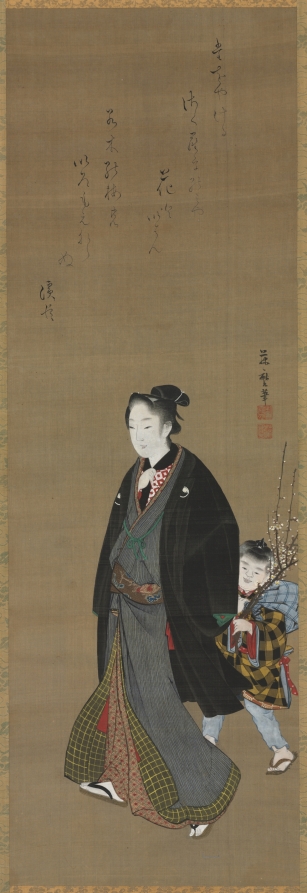| schema:description 10 | "inscription: Artist's signature and two seals middle right side" |
| schema:description | "wall_description: A young man strolls in front of a boy carrying flowering plum
branches, perhaps symbolic of spring. The colors and patterns
in the boy’s clothing, along with the plum branches at the
edge of the painting, introduce an element of movement and
surprise. This image is similar to the composition of Courtesans
and Attendants by Engetsudo (see 1985.255).
The poem inscribed at the top reads:
The full blooming cherry is not the only flower
worth mentioning.
The color of the young plum tree blooms as well.
The Japanese word for color, iro, is a double entendre for love or sex. The full blooming cherry refers to the mature female courtesans of the Yoshiwara district of Edo (Tokyo), while the young plum refers to handsome young men, who the poet suggests one not overlook in the pursuit of pleasure.
Kitagawa Fujimaro was a disciple of renowned painter and print designer Kitagawa Utamaro (1753?–1806)....(more)" |
| schema:description | "collection: ASIAN - Hanging scroll" |
| schema:description | "measurements: Overall: 180.4 x 48.3 cm (71 x 19 in.); Painting only: 94 x 31 cm (37 x 12 3/16 in.)" |
| schema:description | "id: 152428" |
| schema:description | "type: Painting" |
| schema:description | "technique: hanging scroll; ink and color on silk" |
| schema:description | "tombstone: Man Strolling with a Boy Carrying Flowering Branch, c. 1810. Kitagawa Fujimaro (Japanese, 1790-1850). Hanging scroll; ink and color on silk; overall: 180.4 x 48.3 cm (71 x 19 in.); painting only: 94 x 31 cm (37 x 12 3/16 in.). The Cleveland Museum of Art, The Kelvin Smith Collection, given by Mrs. Kelvin Smith 1985.256...(more)" |
| schema:description | "creditline: The Kelvin Smith Collection, given by Mrs. Kelvin Smith" |
| schema:description | "culture: Japan, Edo period (1615-1868)" |

